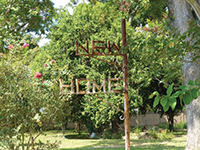 A LITTLE PIECE OF HISTORY | By Joan Frances –
A LITTLE PIECE OF HISTORY | By Joan Frances –
Abandoned graveyards have always been a fascination for historians. They dig deep to unearth the stories of the past in an attempt to uncover the fortitude of the working man and the roots of the community. Many of these tales are handed down from generation to generation. When a visitor walks through a diminutive cemetery, they may sense an inexplicable feeling that they are not alone. The spirits of the deceased seem to be reaching out to tell their stories. Do ghosts really exist? No one knows for sure, but one intriguing and mysterious plot of land that has proven to be a landmark for residents of Fort Bend County is the grave site at FM 1464 and Old Orchard Drive.

The sign post at New Home Cemetery.
Located at the entrance to the subdivision of Orchard Lakes Estates in Sugar Land, the cemetery is home to over 30 graves, most of them with no headstone, and was created more than 130 years ago. Originally, New Home Missionary Baptist Church and the cemetery shared this plot of land. The church has been gone for many years.The small cemetery provided a resting place for the African American communities of Richmond, Rosenberg, Four Corners, Sugar Land, Stafford and Missouri City.
As Fort Bend County was growing, the Harlem Prison Farm hired African Americans to work at the prison and the post office located on the prison farm. Many of the residents went to work at the sugar mill in Sugar Land as well, dedicating countless hours of work for very little pay. When they passed away, some of these workers were buried at New Home Cemetery, not far from their homes. Descendants of the people who built Sugar Land still live in the houses behind the sugar mill and in the Four Corners community.

Burial sites at New Home Cemetery.
The Schoeman family originally owned the cemetery, but with no maintenance and overgrown plants, it began to deteriorate. Rosa Bryant and the New Home Cemetery Burial Association took over the care. In 1994, Woodrow (Woody) Jones, President of Project R.E.S.P.E.C.T., (Restoration, Enhancement, Stabilization, Protection, Evaluation, Curation and Technology) bought out the smaller company to care for the land, which he still maintains today. According to Jones, in 1995, there were approximately 4,000 abandoned African American cemeteries in the state of Texas. Beazer Homes originally purchased the land surrounding the cemetery and developed a new subdivision around the grave sites. When manmade lakes were added, three feet of soil was brought in to raise the elevation of the grave yard. Then in 2010, expansion of FM 1464 by the Old Orchard Drive intersection forced some of the graves to be relocated. Department of Transportation crews and archeologists went digging for coffin nails, coffin wood and any bone remains. Twenty-six bodies were buried in the ditch, many of the bones were from unmarked graves and all were carefully transferred to another location on the cemetery property.
Today, New Home Cemetery is protected, with long term plans to convert the cemetery into a burial park. The limited tombstones, some dark and aged, reflect the years of life and death of Fort Bend residents. There have been reports of strange lights darting across the cemetery late at night. One never knows what tales are facts or fabrication. One thing is undeniable: The allure these stories hold and the challenge to seek the truth is well worth every anecdote. For now, the mystery is revealed. As Jones stated so eloquently, “Buried here are the people on whose shoulders and whose backbone built this community.”